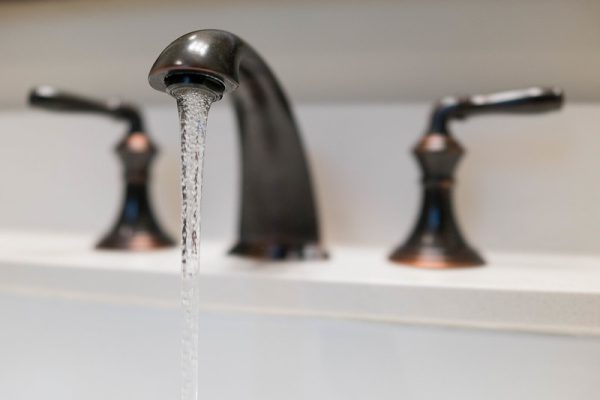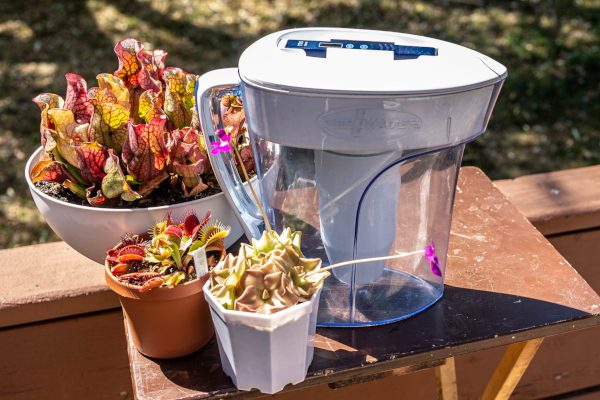Full sized venus flytraps do not typically eat gnats or fruit flies. Gnats & fruit flies are too small to trigger the hairs to make the trap close on a venus flytrap. A smaller venus flytrap from 1-2 years old may be small enough to eat gnats and fruit flies. Even though venus flytraps eat gnats and fruit flies at a young age they are not the best carnivorous plant for gnat or fruit fly control.
Lets talk more about what carnivorous plant you can get to control those pesky gnats and fruit flies!
Buy Carnivorous Plants Online!
Table of Contents
Pinterest
Facebook
Twitter
Reddit
Do Venus Flytraps Eat Gnats & Fruit Flies?
If you grow venus flytraps from either seed or propagation, you may have some around that are small enough to eat fruit flies and gnats. Typically, you are not getting venus flytraps for gnat or fruit fly control. Even the young venus flytraps that are capable of eating the gnats or fruit flies don’t have enough traps on them to actually make a difference.
You could even debate that if a gnat were to trigger a full sized venus flytrap to close its trap it probably expends more energy trying to digest the gnat or fruit fly than it will get from the insect due it it’s small size. The venus flytrap has evolved to know it needs a larger insect to trigger the trap for it to be worth expending the energy to close.
The other issue is that venus flytraps actually need to be triggered twice. 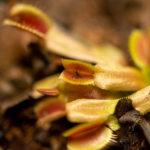 They have evolved to know that it’s possible for a leaf or rain drop to trigger the trap to close. The venus flytrap actually waits for a secondary trigger once the trap closes. If the thing inside is not moving, the flytrap will likely not go thorough with full digestion to save energy. Digestion will only trigger if the thing its trapped is moving around on the inside and triggers the hair a second time. The flytrap then releases it’s digestive enzyme to eat it’s prey. A gnat would not be big enough to trigger the secondary response.
They have evolved to know that it’s possible for a leaf or rain drop to trigger the trap to close. The venus flytrap actually waits for a secondary trigger once the trap closes. If the thing inside is not moving, the flytrap will likely not go thorough with full digestion to save energy. Digestion will only trigger if the thing its trapped is moving around on the inside and triggers the hair a second time. The flytrap then releases it’s digestive enzyme to eat it’s prey. A gnat would not be big enough to trigger the secondary response.
Carnivorous Plants That Eats Gnats & Fruit Flies
Venus flytraps are amazing and one of the coolest carnivorous plants.They are small enough to eat gnats and fruit flies but will not make much of a dent with an outbreak. However, there are some amazing carnivorous plants that you can get pretty easily that will help you control your gnat and fruit fly problem.
Were going to talk about some amazing carnivorous plants that will definitely eat some fruit flies and gnats in enough of a quantity that can actually help you out!
Mexican Butterworts or Pinguicula
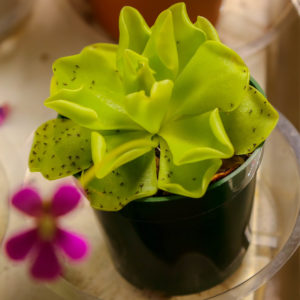
PINGS! One of my favorite carnivorous plants! These amazing carnivorous plants are not only better for eating gnats and fruit flies but they are even easier to care for! Venus flytraps can be really tricky to care for. They need full sun or at the very least a very strong grow light for 12-15 hours a day. Venus flytraps will not typically grow well on a window sill either, making them tricky to really care for. Venus flytraps also need a winter dormancy period. All of these factors make venus flytraps tricky to grow.
Pings (short for pinguicula) are much easier to care for.
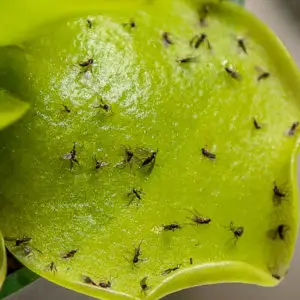
Each leaf on a ping can capture and eat many gnats or fruit flies.
They do still need light, but not nearly as much as a venus flytrap. They actually do really well on window sills and don’t typically need any kind of winter dormancy. But, most importantly, they can consume massive quantities of gnats and fruit flies. I had a breakout last year and my ping CLEANED up the gnats and fruit flies. Check out the video below so you can see just how many gnats and fruit flies my ping took care of.
If you are interested in purchasing a ping, California Carnivores has a huge selection. I recommend a “Sethos” or “Weser” as they are pretty easy to care for but there are so many other great pinguicula out there you can get eat gnats and fruit flies. Also, make sure to enter CPHUB at check out so you can get 10% off your order!
Order A Ping From California Carnivores, Click Here!
(Use CPHUB For 10% Off)
I actually have a YouTube channel where you can see my carnivorous plants. I did a video all about how my pinguicula was catching gnats and fruit flies. Check it out below! Click the icon in the upper left to subscribe to my channel for updates on this very plant!
https://youtu.be/-PsUgnwdB0A
Another thing I really love about pings is they produce beautiful little flowers. These flowers are often pinkish or purple that are always a great contrast to the green ping. You can get all different colors of pings that produce all different colors of flowers. If a ping is healthy, it can produce several flowers are a time. When the flowers are blooming, these little carnivorous plants are beautiful but also lethal!
Cape Sundew Or Drosera Capensis
Another great carnivorous plant that likes to eat gnats and fruit flies is the Cape Sundew. These are quite a bit different than pings but just as impressive. They grow long tentacle type leaves that develop little drops of dew. This dew is very stick and traps insects. The plant then releases an enzyme that breaks the insect down and uses it for food.
These are just a bit more high maintenance than pinguicula. They need a little more light and just an uptick in humidity to continue to produce the dewy substance that traps the insects. They can do well in window sills if the window gets a lot of sun. They really like hanging out in a bathroom or kitchen sink. Being above a sink helps them get a little boost in humidity.
Like pinguicula, they are much easier to take care of than venus flytraps. They also do not need any type of dormancy period. This helps them be useful for gnats or fruit flies year round!
If you are interested it getting yourself a Cape Sundew California Carnivores is a great option! They are one of the most trusted and knowledgeable carnivorous plant nurseries around. Plus, you can get a 10% discount using the code CPHUB at checkout!
Order A Sundew From California Carnivores, Click Here!
(Use CPHUB For 10% Off)
If you want to see more of a Cape Sundew, you can check out the video I did talking about mine. They are really cool plants and whether you have a gnat problem or not, they are a lot of fun to have around the house! Check it out below!https://youtu.be/1b9b2MsApTA
Do Venus Flytraps Eat Gnats: Conclusion
I often get the question on my YouTube channel, do venus flytraps eat gnats and fruit flies? It really comes down to the size of the venus flytrap. If it’s smaller it will eat gnats and fruit flies.
When it really comes down to it though, it doesn’t matter if a venus flytrap eats gnats or fruit flies because they can’t eat enough to help control the number of gnats or fruit flies you likely have. This question is asked because people want a natural way to help control these tiny insects. Venus flytraps are not the answer for that.
The good news is that there are some other truly amazing carnivorous plants that are easier to care for and do a MUCH better job of eating gnats and fruit flies in large quantities. Most people have no idea that there is a wide world of incredible carnivorous plants out there! If you are interested in learning more, head on over to my YouTube channel and see some of my personal collection!



